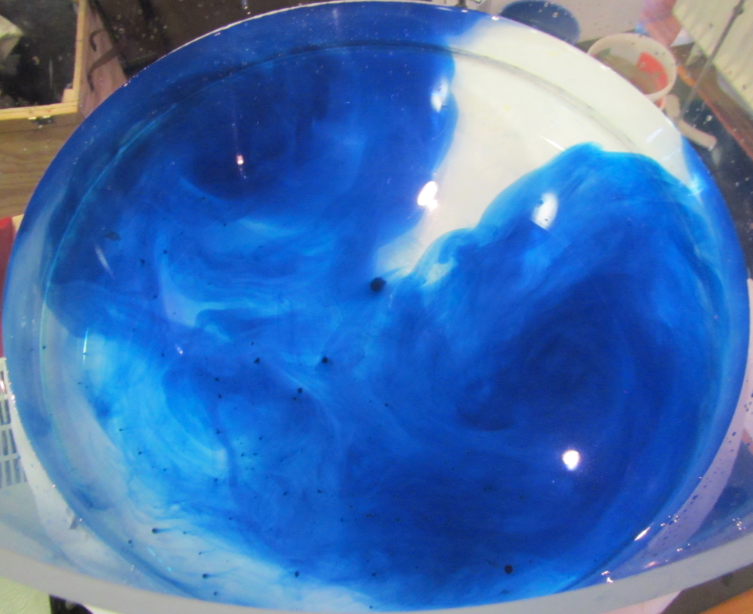
Collapsing column
Or: This is what happens to a hetonic explosion experiment without rotation.
I’ve posted a lot while at JuniorAkademie a while back, so it is hard to believe there are still experiments from that time that I haven’t shown you. But I’ve probably only shown you about half the experiments we’ve done, and there are plenty more in the queue to see the light of day on this blog!
Today I want to talk about hetonic explosions (you know? The experiment on the rotating tank where a denser column of water at the center of the tank is released when the whole tank has reached solid body rotation). In Bergen, we used to show this experiment as a “collapsing column” experiment, the tilting of a frontal surface under rotation. For those cases, all the parameters of the experiment, e.g. the rotation rate, the density contrast, the water height, the width of the cylinder, were set up such as to ensure that one single column would persist in the middle of the tank. At JuniorAkademie, we’ve also run it in other setups, to form dipoles or quadrupoles. For a real hetonic explosion, we would typically go for even more eddies than that.
Today I want to show you this experiment under very special conditions: The no rotation case!
For all of you oceanographers out there who know exactly what that experiment will look like, continue reading nevertheless. For all of you non-oceanographers, who don’t know why some oceanographers might be disappointed by this experiment, continue reading, too!
You see, one of the fundamental assumptions we often make when teaching is that what is exciting to us, the instructor, is exciting to the students, too. And the other way round – that experiments that we might find boring will be boring the students, too. But I often find this to be completely wrong!
In case of the hetonic explosion experiment with no rotation, the experts know what will happen. We pull out the cylinder containing the denser water, so the denser water column will collapse and eventually form a layer of denser water underneath the rest of the water. We know that because we are aware of the differences between rotating and non-rotating systems. However, many students are not. And if you don’t have a strong intuition of how the water will behave, i.e. that in this case you will eventually have two layers, rather than a dense column surrounded by lighter water, it is not terribly exciting when you finally do the rotating experiment and – contrary to intuition – the dense water does not end up below the lighter water. So in order to show you in my next post what to be excited about, today I am showing you the normal, non-rotating experiment:
But note that the experiment is not nearly as boring as you might have thought! We had put a lot of vaseline at the bottom of the cylinder to prevent the denser water from leaking out, so when the cylinder was pulled up, it gave an impulse to the dense column, which ended up splitting up into a dipole upon hitting the wall of the tank. Still looks pretty cool, doesn’t it? And for this to be a good teaching video, I really should have continued filming until the layers had settled down. In my defense I have to say that we had a second experiment set up at the other rotating table that we wanted to run, so I had to get the cameras over to the other table… And you’ll see those movies in my next post!

Simulations of hetonic explosions - Adventures in Oceanography and Teaching says:
[…] looking at a non-rotating cylinder collapse the other day, it is time to look at proper hetonic explosions (you know? The experiment on the […]
The effects of rotation on a collapsing column | says:
[…] the non-rotating experiment (which was, by the way, set up carefully in preparation for a rotating experiment, but then the […]
Simulations of hetonic explosions | says:
[…] looking at a non-rotating cylinder collapse the other day, it is time to look at proper hetonic explosions (you know? The experiment on the […]